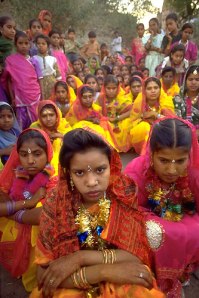by Sylvie Hughes
Gurgaon,India
5th November 2013
Child marriage in India affects a large portion of adolescent girls in the country. With 47% of girls in India marrying below the legal minimum age of 18, India has the highest number of child brides than any other nation in the world.
Gurgaon,India
5th November 2013
Child marriage in India affects a large portion of adolescent girls in the country. With 47% of girls in India marrying below the legal minimum age of 18, India has the highest number of child brides than any other nation in the world.
However, despite its huge number of illegal marriages, in October India refused to sign the first ever UN resolution against the practice of child marriage – an initiative which is being supported by 107 other countries worldwide.
Child brides face a multitude of serious mental and physical health problems. Young married girls face problems of sexual and domestic abuse, causing high rates of severe depression. Girls as young as 13 drop out of school once they get married, and as a result they are unable to continue their education or seek help. The section of society who are the most in need of education, health and hygiene awareness are unable to access it. This leads to an increase in serious health risks caused by early childbirth and lack of menstrual hygiene awareness.
Girls below the age of 15 are five times more likely to die in childbirth than women in their 20s. With over 50% of adolescent girls in India suffering from anaemia, the increased blood supply demand during pregnancy causes even more of a strain on their health. According to the National Commission for Protection of Child Rights (NCPCR), early marriage and adolescent pregnancies are one of the main causes of anaemia amongst girls in India.
Adolescent pregnancies are also one of the main reasons for infant deaths in hospitals. Children born to adolescent mothers are twice more at risk of neonatal mortality (death within the first month) than those born to older mothers, and the younger the mother, the higher the risk. Many infants are born underweight due to the mother suffering from malnutrition and anaemia, which further increases the risk of health problems and death for the infant.
Educating girls in Menstrual Hygiene and healthcare can be a crucial element in reducing the number of child marriages in India. Access to Menstrual Hygiene awareness projects provide girls with knowledge on proper nutrition and hygiene practices to avoid suffering from anaemia on the onset of menstruation, as well as educating girls about the numerous health risks that are caused by early marriage. Increased awareness decreases not only the 23% school drop out rate from menstruation-related problems, but also the number of girls entering into child marriage.
Preventing adolescent births have been proven to significantly lower population growth rates, improving the health of adolescent girls and potentially generating large economic and social benefits for the country as a whole.
HEEALS (Health, Education, Environment And Livelihood Society), is working on a Menstrual Hygiene awareness and Girl Education project in five states: Delhi (National Capital Region), Uttar Pradesh, Rajasthan, Leh Ladakh, Himachal Pradesh and Haryana. HEEALS works in slum schools, schools in unauthorised colonies, orphanages and refugee camps. Through spreading education on Menstrual Hygiene and providing iron supplement tablets through our Free Health Camp initiative, HEEALS is working to eradicate the practice of child marriage and provide better futures for girls across India’s society. Find out more about its Menstrual Hygiene and Girl Education Project at www.heeals.org and support our work!
Stats Sources: UNICEF, PLAN India, NCPCR, UNFPA


.jpg)

This comment has been removed by a blog administrator.
ReplyDeleteThis comment has been removed by a blog administrator.
ReplyDelete